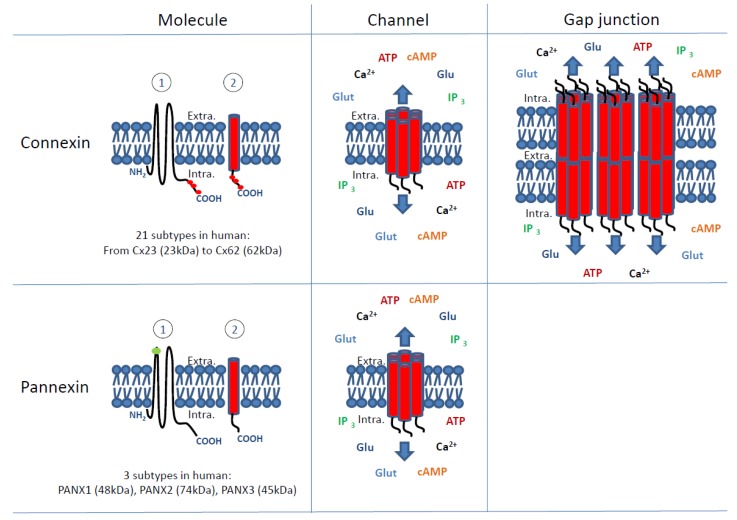Figure 1.
Connexin and pannexin molecules and channels formed by these molecules. As molecules, connexins (Cx) and pannexins (Panx) have similar topology with four transmembrane and intracellular (Intra.) NH2 and COOH domains. In the left panels, both kinds of molecules are shown in a “spread” way to distinguish their topology (1) and in a “condensed” way (2) to better represent as transmembrane subunits of channels (centre panels) and gap junctions (right panel). In humans, 21 subtypes of connexins have been characterized, which are differentially expressed in tissues [8]. They are named according to their expected molecular weight (kDa) from the smallest connexin (Cx23: 23 kDa) to the largest one (Cx62: 62 kDa). The best-known member of the connexin family is the connexin43 (Cx43) which is the most common in the organism. Only 3 pannexin subtypes are known in human (PANX1, PANX2, PANX3) [9,10]. Except for Cx26, connexins can be phosphorylated mostly at their intracellular COOH tail (red spots) [11]. The level of phosphorylation potentially modifies channel gating, interaction with intracellular or other membrane proteins (connexin interactome) and thus their function and life cycle [11,12]. So far, pannexins do not appear to be regulated by phosphorylation as connexins are but they are more characterized as potentially N-glycosylated (green spots) molecules at their extracellular (Extra.) domain. Both connexins and pannexins can aggregate to form hexameric transmembrane channels permitting the passive passage of ions (e.g., Ca2+) and small (<1–1.5 kDa) hydrophilic molecules such as nutrients (e.g., glucose: Glu), amino acids (e.g., glutamate: Glut), nucleotides (e.g., ATP) and second messengers (e.g., cAMP and IP3). Theoretically, connexin-made channels (connexons also called hemichannels) and pannexin-made channels (pannexons) are permeable to the same type of ions and molecules even if pannexons permeability has been mostly studied for ATP, Ca2+ and glutamate (Glut). Moreover, connexons from one cell can dock with connexons of juxtaposed cells forming intercellular channels aggregated in gap junctions which permit the direct intercellular transfer from cytosol to cytosol (gap-junctional intercellular communication, GJIC) of same ions and molecules as isolated connexons. So far, no pannexon-made gap junctions have been described in physiological/pathological conditions. The term connexon is mostly used to define the transmembrane unit of gap junctions. When isolated in the plasma membrane, connexons are usually called hemichannels and can open with various stimuli such as, for example, hypoxia. For clarity in the figure, putative phosphorylation sites (red spots) and N-glycosylated sites (green spots) are not shown in channels and gap junctions.

